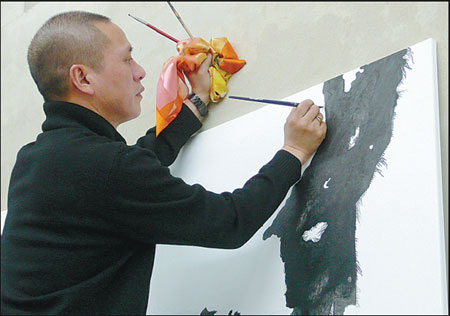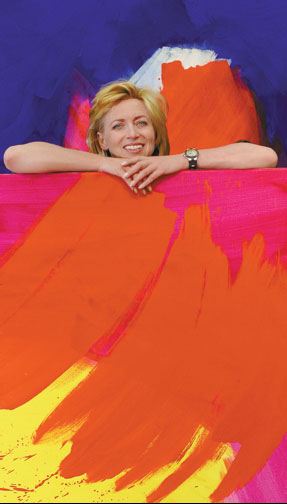

Abstract works fascinate people of varied cultural backgrounds not only because they challenge viewers' perceptions of art, but because every abstract work is exclusive and catches the fleeting emotions of its creator.
The Abstraction exhibition at the Today Art Museum lends more enchantment and depth to the realm of abstract art, both through the powerful pigments of the West and the reserved black-and-white of the East.
German artist Ingeborg zu Schleswig-Holstein and her Chinese artist friend Shan Fan collaborate in this intercultural dialogue to visualize their distinct views of abstraction, and let the audience decide whether their works have achieved resonance.
It is Schleswig-Holstein's third joint exhibition in China with Shan, whom she has known for nearly two decades, and her debut in Beijing. Using colors such as orange, yellow and blue in great volume, she constructs a spiritual paradise of passion and nobility.
"When looking at my works, people cannot help but ask me, 'Why are you so captivated by abstraction that you don't bother portraying the real happenings around you?'" says Schleswig-Holstein.
She prefers to document the inner-self which "is invisible but a brand-new world". She furnishes the small universe of herself with rich colors, just like "a composer plays violin and beats drums to complete music".
"I often find a striking resemblance between my paintings and how outer space looks in an astronomical telescope, or the magnified images of molecular structure and human cells. They represent realities but all look quite abstract because they bear information that people need to decode," she says.
"There is no absolute abstraction, because abstraction exists in all forms of reality that people need to discover."
For Shan, a native of Zhejiang province who lives and works in Hamburg, his spiritual home is built upon the beauty of bamboo and poetic flows of ink on paper. He revisits bamboo as a reoccurring theme in his works on show.
Shan departs from the conventional approach of painting bamboo, a cultural symbol in traditional Chinese art. Rather, he magnifies the textures of bamboo, which he details with abstract brushwork. In his Slowness series, he paints bamboo with oil pigments on canvas.
"There was no pure expression of abstraction in the Chinese painting traditions for several thousand years, which underlined the approach of imagery as the essence. Therefore I experiment with purely abstract presentation of bamboo in a methodological way."
The two artists became each other's first critic by commenting on the counterpart's art before the opening ceremony.
Schleswig-Holstein says Shan's dedication to specializing in bamboo attests to his Chinese soul; while his German soul explores Western techniques to convey Oriental aesthetics. He intentionally paints at a slow pace.
"Shan says he has a post-modernist personality. He lives a parallel life by painting with ink every morning like a Zen Buddhist; in the evening he paints with oil. He lives with his Chinese and German souls in happy coexistence on a daily basis," she says.
Shan recollects his first visit to Schleswig-Holstein's studio several years ago.
He remembers the big, messy space with paintings hung all over on the wall and the floor covered with paper. Meanwhile he was impressed by its owner, who was calmly creating artwork.
"Her application of colors reflects influences of the Pop Art movement," Shan says. "She assisted Andy Warhol at his New York studio The Factory in the 1980s. But the emotions expressed in her paintings feel quite Oriental, even more than that of my works."
If you go
10 am-6 pm, until April 12. Today Art Museum, 32 Baiziwan Lu (Road), Chaoyang district, Beijing.
010-5876-0600 Ext 100.
linqi@chinadaily.com.cn
 |
|
Shan Fan shows the charm of bamboo with abstract brushwork. Photos provided to China Daily |
 |
|
Ingeborg zu Schleswig-Holstein displays her works in Beijing. |